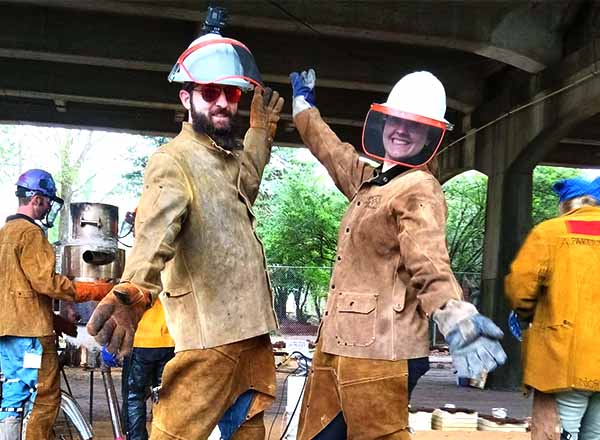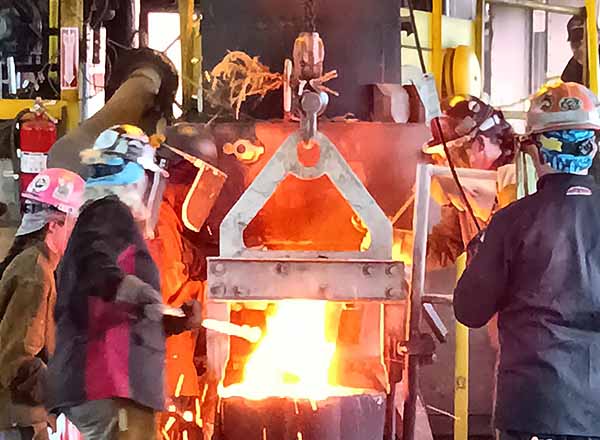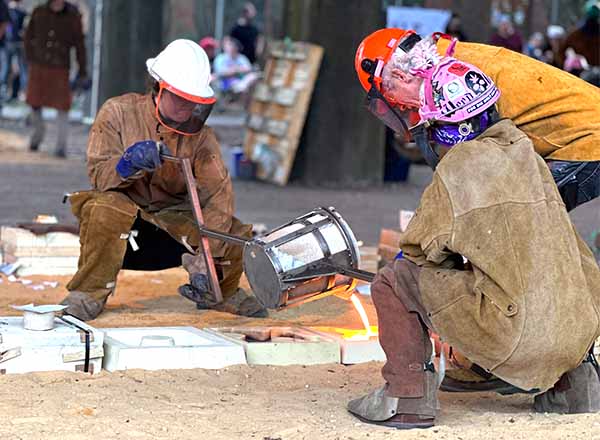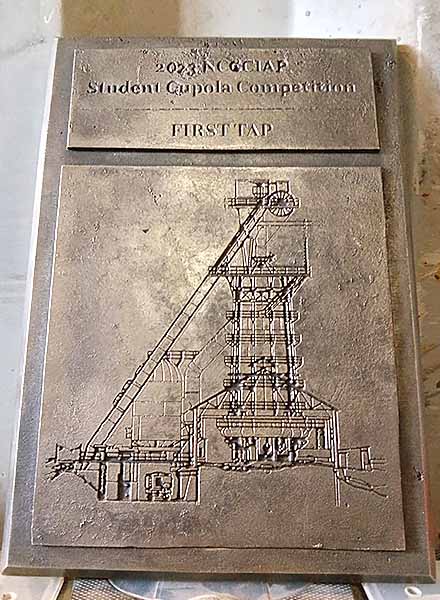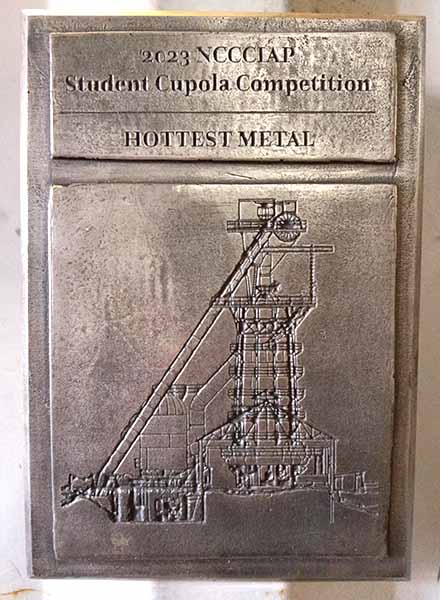HFC, first community college in national metal-pouring competition, beats university competitors
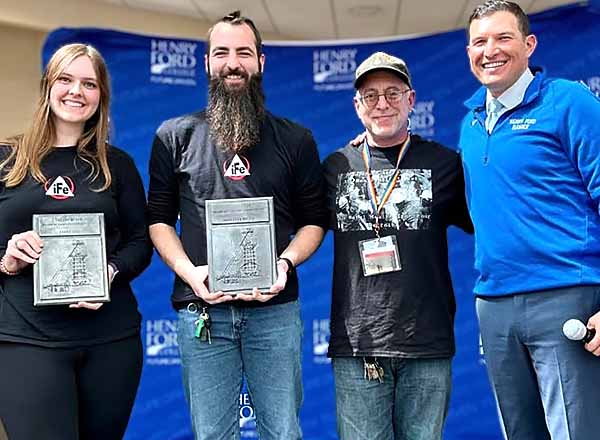
A team of students from the Henry Ford II Honors Program scored high at the Student Cupola Contest at Sloss Furnaces in Birmingham, AL.
Calling themselves the “Ironic Femmes,” these honors students – Bryant Bagnall, Alayna Kondraciuk, and Savanna Vela, under the sponsorship of fellow honors student Jay Elias – earned the following honors:
- First Tap: This honor goes to the first team to empty their furnace in the competition.
- Hottest Metal: This honor is decided through a fluidity test mold each team was given to pour.
(The name “Ironic Femmes” is a double play-on-words reference to the material used: "Ironic" is a pun in reference to iron, and "Fe" is the periodic table symbol for iron.)
“You have to understand: The three students never did metal-pouring before. This was their first time doing this. We were the first ones done. I felt like a proud papa,” said Elias, an artist whose medium is metal. He is the founder of Evolution Art Studio in Detroit.
First community college ever to participate
To make this victory even sweeter, this was the first time any community college participated in this contest. The Ironic Femmes competed against students from Yale University, Appalachian State University, the University of North Carolina at Greensboro, the University of Kentucky, Colorado Mesa University, the Massachusetts College of Art and Design (MassArt), and the University of Tennessee, Knoxville.
“That was some pretty stiff competition,” said Elias. “It is hard to overstate what the HFC students accomplished. This is akin to attending a slam-dunk contest with the likes of Michael Jordan and Scottie Pippen and beating the pants off them your first time out!”
Kondraciuk wasn’t aware HFC was the first community college to participate in this contest until they were in Alabama.
“It increased the stakes, especially competing against prestigious schools like Yale and MassArt,” she said. “I was nervous but determined to give it my all. When our team finished and I looked around and saw other teams still going, I was super shocked and relieved. I didn't fully grasp our accomplishment until I saw Jay. He was excited and overjoyed. He said our win as the underdogs is equivalent to an average student dunking on Michael Jordan. After all, we were up against art students who pour metal frequently. We had no experience other than two test pours.”
“After two test pours in Detroit, they were ready”
HFC’s participation in the Student Cupola Contest goes back to last summer. After earning the Englehardt Social Justice Fellowship through the University of Michigan in Ann Arbor, Elias was given a $5,000 grant to continue pouring metal. He also attended the International Conference on Contemporary Cast Iron Art in Berlin, Germany. There, he met people on the National Conference on Contemporary Cast Iron Art and Practices Steering Committee. They informed him about competing in the Student Cupola Contest.
Elias spoke to Honors program director Dr. Adam Hazlett about forming a team of honors students to show them how to build and run a furnace to enter this competition. Hazlett pledged his support and offered funding through the Mellon Foundation.
“We entered, got accepted, and started preparing,” recalled Elias. “The Detroit Design Center let me use its studio and donated materials so we could build a furnace. They let the four of us use this space, where I taught them how to weld and how to use the tools needed to finish metal sculptures. After two test pours in Detroit, they were ready.”
Recruitment led to an “exceptional show of technical teamwork”
Kondraciuk remembered how Elias recruited her into the project.
“Jay came up to me in the Honors Hub last fall and asked, ‘Do you want to pour liquid iron and go to Alabama?’ I immediately said yes without knowing anything about metal pouring and the process. It was a super fun learning experience for me,” she said. “Jay actually couldn't participate in the competition. He has too much experience in metal pouring. Instead, he was our sponsor, along with Dr. Hazlett. Bryant, Savanna, and I were on the official team. In fact, we were the pouring crew. We were in charge of lifting the heavy liquid metal and pouring it into molds. Together, we poured more than 300 pounds of iron before some even filled a single cup!”
Bagnall confessed he didn’t know what was getting himself into when Elias recruited him.
"My experience at Sloss came without foresight. I accepted an invitation – which was really recruitment – from Jay to go to Alabama for a metal pour,” he said. “I had no clue that a few friends and I would be on the floor pouring the iron ourselves. What felt like a routine pour, due to my lack of experience, was in reality an exceptional show of technical teamwork. I remember being able to take off my leathers and put them away before it dawned on me that all other seven schools were still in the running for second place. This is about the time I found out we were the first community college to participate in the history of this competition!”
Bagnall continued: “The community around this form of art is one of the kindest groups of people I have met. Everyone was so supportive and willing to give advice and wisdom. This experience has given me more confidence in myself, as well as in those I bonded with over liquid iron. It takes a team to pour. I would pour with this team many times over."
Kondraciuk agreed.
“The best part of this trip was the learning experience,” she said. “In January, I had no idea what metal pouring entailed. Terms like ‘bots,’ ‘slag,’ and ‘charges’ were used and I didn't know what any of them meant. After our two test pours, I better understood how we melted and extracted the metal from the furnace. I learned even more at the conference. I am extremely grateful for this experience.”
HFC is innovative in its educational offerings
Elias couldn’t express his pride in the Ironic Femmes enough.
“They were way out of their comfort zone, especially Savanna. She went in very timid and came back like a tigress. She absolutely killed it! It was great to watch,” he said.
"It feels surreal," said Vela. "I spoke with Jay the following week after the competition and I told him I couldn’t grasp how important this win is for HFC. I’m so proud to represent the College and I couldn’t have asked for a better team."
For Elias, being able to introduce people who wouldn’t normally have access to a cast iron foundry, the process of producing molten iron, and enabling them to experience and facilitate that learning process was the best part of this endeavor.
“We got to bond and check out Birmingham, which has a rich history of its own. It was a great trip all the way around. We met a lot of college students from all over the country. It enriched the team's college experience, being able to travel and participate in this academic event where they would not otherwise had access to it had I not pushed and challenged the norm. We didn’t just enter the competition; we took home some pretty prestigious awards!” he said. “It was really special. It would be amazing to go every couple of years and represent HFC at this prestigious academic event.”
Hazlett gave a nod to the efforts of President Russell Kavalhuna, Vice President of Academic Affairs Dr. Michael Nealon, and Vice President of Institutional Advancement A. Reginald Best.
“Without their unwavering support from the very moment Jay brought this opportunity to me, it would not have been possible for HFC to best the likes of Yale and MassArt in a fine arts competition,” he said. “This shows HFC is truly future-driven and seeks out new and challenging ways to innovate in education.”
